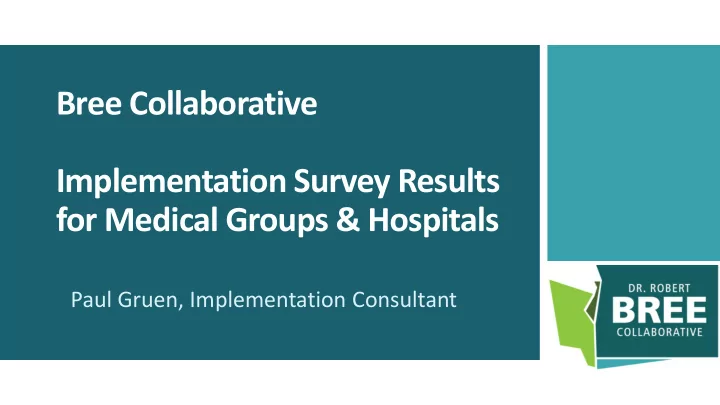

Bree Collaborative Implementation Survey Results for Medical Groups & Hospitals Paul Gruen, Implementation Consultant Click to add date | Click to add location
13 Bree Collaborative Topics, 1 to 115 recommendations per topic Obstetrics Care Oncology Care Cardiology: Appropriate PCI Addiction & Dependence Treatment CABG Surgical Bundle Opioid Prescriptions Spine/Low Back Pain End Of Life Care Planning Spine SCOAP Avoidable Hospital Readmissions Lumbar Fusion Surgical Bundle Knee/Hip Replacement Prostate Cancer Screening Slide 2
Implementation Survey Separate hospital and medical group surveys Surveys are voluntary, self-reported (inter-rater reliability) Bias towards larger urban & suburban systems Implementation possibly independent of Bree Recommendation Low implementation could mean “unknown” Extensive length of survey reduced response rate Slide 3
Participating Hospitals &Medical Groups CHI Franciscan Health Swedish/Providence 5 hospitals 5 hospitals, 3 medical groups Confluence Health UW Hospital & medical group 4 hospitals The Everett Clinic Vancouver Clinic Evergreen Health Partners Virginia Mason Hospital & medical group Group Health Northwest Physicians Network Polyclinic Slide 4
Implementation Scoring Scale 0 -No action taken 1 -Actively considering adoption 2 -Some/similar adoption 3 -Full adoption Slide 5
MG #1: Addiction & Dependence Treatment (Average Score: 1.46) (28 recommendations x 10 medical groups) 100 80 Count 60 40 20 0 0 1 2 3 Assessment Score Slide 6
MG #1: Addiction & Dependence Treatment (lowest scoring recommendations) Verbal communication takes place with the chemical dependency treatment facility to follow-up on any referrals and assess whether treatment was initiated and/or completed (0.75) The patient’s perspective is included as work is done to increase the capability of the chemical dependency system (0.75) Patients are contacted after they have been referred to chemical dependency treatment to address any barriers to accessing treatment (0.88) Patient results from alcohol and other drug misuse screens are tracked over time (1.00) Slide 7
MG #8: Obstetrics (Average Score: 2.74) (5 recommendations x 7 medical groups) 30 25 20 Count 15 10 5 0 0 1 2 3 Assessment Score Slide 8
Knee and Hip Replacement Surgical Bundle 11 hospitals 87 recommendations 2.32 Average Score Cycle 1: Disability Despite Conservative Therapy Cycle 2: Fitness for Surgery (9 recommendations) (31 recommendations) 200 50 40 150 Count Count 30 100 20 50 10 0 0 0 1 2 3 0 1 2 3 Assessment Score Assessment Score Cycle 4: Return to Function Cycle 3: Repair of Joint (19 recommendations) (18 recommendations) 140 120 120 100 100 80 Count 80 Count 60 60 40 40 20 20 0 0 0 1 2 3 0 1 2 3 Assessment Score Assessment Score Slide 9
Knee and Hip Replacement Surgical Bundle (5 lowest scoring recommendations) Cycle 2: General health questionnaire completed: Patient Reported Outcomes Measurement Information System-10/PROMIS-10 (1.09) Cycle 2: Patient participates in Shared Decision-making with WA State- approved Decision Aid (1.36) Cycle 2: HOOS/KOOS survey completed (1.60) Cycle 4: Patient-reported functional outcomes are measured with KOOS/HOOS instrument (1.55) Cycle 4: If opioid use exceeds six weeks, a formal plan is developed for opioid management (1.55) Slide 10
Hospitals: Appropriate PCI / COAP (Average Score: 3.00) (3 recommendations x 7 hospitals) 25 20 Count 15 10 5 0 0 1 2 3 Assessment Score Slide 11
Top BARRIERS to Adoption Lack of availability & credibility of data, and burden to collect it Business case- no economic reward, and lack of contract partners interested in value-based purchasing Lack of consensus on what constitutes quality of care Slide 12
Top ENABLERS to Adoption Existing organizational improvement program for minimizing errors & waste Business case- evidence of economic reward Consensus on what constitutes quality of care Individual provider-level performance feedback Slide 13
Implementation- Key Lessons: 1 - 4 1. Systematic collection of patient self-reported goals, function & outcomes tracking are a challenge (STarT Back tool, Functional Recovery Questionnaire, Oswestry, PROMIS-10, KOOS/HOOS, Opioid pain assessment, Cancer Care treatment goals) 2. Patient Decision Aids not yet available and shared decision making not systematic (Prostate/PSA testing, knee/hip replacement) 3. Some recommendations may not be adopted as broadly as Bree specifies (advance care plans >18 y.o., drug & alcohol screening in ED >13 y.o.) 4. Communication between entities not systematic (advanced directives/POLST, PMP for Opioids) Slide 14
Key Lessons: 5-10 5. Long-term opioid use planning a challenge, also Prescription Monitoring Program (PMP) 6. Addiction/dependency referrals, follow-up and tracking not systematic 7. Alignment with “Choosing Wisely” an opportunity (Oncology care, Prostate/PSA screening) 8. Decisions by “Collaborative Team” not yet systematic (Lumbar Fusion) 9. Data issues, business case for implementation significant barriers 10. Organization improvement program, business case, provider level performance feedback significant enablers Slide 15
Next Steps (work in process) Closer examination of providers successful in implementation Work with health plans, particularly on business case WA state “Business Group on Health”? Healthier Washington/Hub, also Patient Decision Aids Choosing Wisely Bundled Payment specifications- revise/update Slide 16
Recommend
More recommend